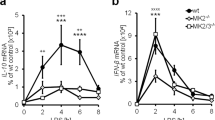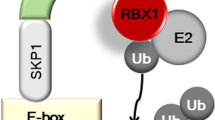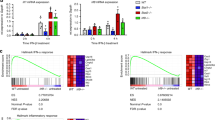Abstract
Suppressor of cytokine signaling (SOCS) proteins are feedback inhibitors of the Janus kinase (JAK) and signal transducer and activator of transcription (STAT) signaling pathway. SOCS3 is upregulated by several signals in macrophages and has been implicated as a regulator of various signaling pathways. Here we show that phosphorylation of STAT3 is prolonged in mouse Socs3-deficient macrophages after stimulation with interleukin-6 (IL-6) but not IL-10, indicating that SOCS3 specifically affects signaling mediated by IL-6 and gp130. IL-6 induces a wider transcriptional response in Socs3-deficient macrophages than in wild-type cells; this response is dominated by interferon (IFN)-regulated genes owing to an excess of STAT1 phosphorylation. Thus, SOCS3 functions to control the quality of the response to IL-6 and prevents the activation of an IFN-induced program of gene expression.
This is a preview of subscription content, access via your institution
Access options
Subscribe to this journal
Receive 12 print issues and online access
$209.00 per year
only $17.42 per issue
Buy this article
- Purchase on Springer Link
- Instant access to full article PDF
Prices may be subject to local taxes which are calculated during checkout




Similar content being viewed by others
References
Kile, B.T. et al. The SOCS box: a tale of destruction and degradation. Trends Biochem. Sci. 27, 235–241 (2002).
Alexander, W.S. et al. Suppressors of cytokine signaling (SOCS): negative regulators of signal transduction. J. Leukoc. Biol. 66, 588–592 (1999).
Alexander, W.S. et al. SOCS1 is a critical inhibitor of interferon-γ signaling and prevents the potentially fatal neonatal actions of this cytokine. Cell 98, 597–608 (1999).
Marine, J.C. et al. SOCS1 deficiency causes a lymphocyte-dependent perinatal lethality. Cell 98, 609–616 (1999).
Metcalf, D. et al. Gigantism in mice lacking suppressor of cytokine signalling-2. Nature 405, 1069–1073 (2000).
Greenhalgh, C.J. et al. Biological evidence that SOCS-2 can act either as an enhancer or suppressor of growth hormone signaling. J. Biol. Chem. 277, 40181–40184 (2002).
Marine, J.C. et al. SOCS3 is essential in the regulation of fetal liver erythropoiesis. Cell 98, 617–627 (1999).
Takahashi, Y. et al. SOCS3: An essential regulator of LIF receptor signaling in trophoblast giant cell differentiation. EMBO J. 22, 372–384 (2003).
Roberts, A.W. et al. Placental defects and embryonic lethality in mice lacking suppressor of cytokine signaling 3. Proc. Natl. Acad. Sci. USA 98, 9324–9329 (2001).
De Souza, D. et al. SH2 domains from suppressor of cytokine signaling-3 and protein tyrosine phosphatase SHP-2 have similar binding specificities. Biochemistry 41, 9229–9236 (2002).
Schmitz, J. et al. SOCS3 exerts its inhibitory function on interleukin-6 signal transduction through the SHP2 recruitment site of gp130. J. Biol. Chem. 275, 12848–12856 (2000).
Nicholson, S.E. et al. Suppressor of cytokine signaling-3 preferentially binds to the SHP-2-binding site on the shared cytokine receptor subunit gp130. Proc. Natl. Acad. Sci. USA 97, 6493–6498 (2000).
Hortner, M. et al. Suppressor of cytokine signaling-3 is recruited to the activated granulocyte-colony stimulating factor receptor and modulates its signal transduction. J. Immunol. 169, 1219–1227 (2002).
Hortner, M. et al. A new high affinity binding site for suppressor of cytokine signaling-3 on the erythropoietin receptor. Eur. J. Biochem. 269, 2516–2526 (2002).
Auernhammer, C.J., Bousquet, C. & Melmed, S. Autoregulation of pituitary corticotroph SOCS-3 expression: characterization of the murine SOCS-3 promoter. Proc. Natl. Acad. Sci. USA 96, 6964–6969 (1999).
Cassatella, M.A. et al. Interleukin-10 (IL-10) selectively enhances CIS3/SOCS3 mRNA expression in human neutrophils: evidence for an IL-10-induced pathway that is independent of STAT protein activation. Blood 94, 2880–2889 (1999).
Stoiber, D. et al. Lipopolysaccharide induces in macrophages the synthesis of the suppressor of cytokine signaling 3 and suppresses signal transduction in response to the activating factor IFN-γ. J. Immunol. 163, 2640–2647 (1999).
Stoiber, D. et al. Listeria monocytogenes modulates macrophage cytokine responses through STAT serine phosphorylation and the induction of suppressor of cytokine signaling 3. J. Immunol. 166, 466–472 (2001).
Bode, J.G. et al. LPS and TNFα induce SOCS3 mRNA and inhibit IL-6-induced activation of STAT3 in macrophages. FEBS Lett. 463, 365–370 (1999).
Dalpke, A.H., Opper, S., Zimmermann, S. & Heeg, K. Suppressors of cytokine signaling (SOCS)-1 and SOCS-3 are induced by CpG-DNA and modulate cytokine responses in APCs. J. Immunol. 166, 7082–7089 (2001).
Shouda, T. et al. Induction of the cytokine signal regulator SOCS3/CIS3 as a therapeutic strategy for treating inflammatory arthritis. J. Clin. Invest. 108, 1781–1788 (2001).
Suzuki, A. et al. CIS3/SOCS3/SSI3 plays a negative regulatory role in STAT3 activation and intestinal inflammation. J. Exp. Med. 193, 471–481 (2001).
Berlato, C. et al. Involvement of suppressor of cytokine signaling-3 as a mediator of the inhibitory effects of IL-10 on lipopolysaccharide-induced macrophage activation. J. Immunol. 168, 6404–6411 (2002).
Donnelly, R.P., Dickensheets, H. & Finbloom, D.S. The interleukin-10 signal transduction pathway and regulation of gene expression in mononuclear phagocytes. J. Interferon Cytokine Res. 19, 563–573 (1999).
Heinrich, P.C. et al. Interleukin-6-type cytokine signalling through the gp130/Jak/STAT pathway. Biochem. J. 334, 297–314 (1998).
Takeda, K. et al. Enhanced Th1 activity and development of chronic enterocolitis in mice devoid of Stat3 in macrophages and neutrophils. Immunity 10, 39–49 (1999).
Lang, R. et al. Shaping gene expression in activated and resting primary macrophages by IL-10. J. Immunol. 169, 2253–2263 (2002).
de Veer, M.J. et al. Functional classification of interferon-stimulated genes identified using microarrays. J. Leukoc. Biol. 69, 912–920 (2001).
Friederichs, K. et al. Interleukin-6-induced proliferation of pre-B cells mediated by receptor complexes lacking the SHP2/SOCS3 recruitment sites revisited. Eur. J. Biochem. 268, 6401–6407 (2001).
Ohtani, T. et al. Dissection of signaling cascades through gp130 in vivo: reciprocal roles for STAT3- and SHP2-mediated signals in immune responses. Immunity 12, 95–105 (2000).
Tebbutt, N.C. et al. Reciprocal regulation of gastrointestinal homeostasis by SHP2 and STAT-mediated trefoil gene activation in gp130 mutant mice. Nat. Med. 8, 1089–1097 (2002).
Cacalano, N.A., Sanden, D. & Johnson, J.A. Tyrosine-phosphorylated SOCS-3 inhibits STAT activation but binds to p120 rasGAP and activates Ras. Nat. Cell Biol. 3, 460–465 (2001).
Costa-Pereira, A.P. et al. Mutational switch of an IL-6 response to an interferon-γ-like response. Proc. Natl. Acad. Sci. USA 99, 8043–8047 (2002).
Park, C., Li, E., Cha, E. & Schindler, C. Immune response in Stat2 knockout mice. Immunity 13, 795–804 (2000).
Croker, B.A. et al. SOCS3 negatively regulates IL-6 signaling in vivo. Nat. Immunol advance online publication, 18 May 2003 (doi:10.1038/ni931).
Acknowledgements
We thank P. Goodell for advice on fetal liver reconstitution and for suggesting the use of the CD45.1+CD45.2+ F1 mice as recipients, and D. Marshall and J. Morris for doing the microarray experiments. This work was supported by grants from the US National Institutes of Health (AI53478-01) and the American Heart Association (grant 344901) to P.J.M., by a grant from Cancer Center CORE (P30 CA 21765) and by American Lebanese Syrian Associated Charities. In the early stage of this work, R.L. was recipient of a fellowship from the Deutsche Forschungsgemeinschaft (LA 1262/1-1). R.L. and J.M. are supported by Nationales Genomforschungsnetzwerk grant 01GS0113.
Author information
Authors and Affiliations
Corresponding author
Ethics declarations
Competing interests
The authors declare no competing financial interests.
Rights and permissions
About this article
Cite this article
Lang, R., Pauleau, AL., Parganas, E. et al. SOCS3 regulates the plasticity of gp130 signaling. Nat Immunol 4, 546–550 (2003). https://doi.org/10.1038/ni932
Received:
Accepted:
Published:
Issue Date:
DOI: https://doi.org/10.1038/ni932
This article is cited by
-
IL-6 prevents Th2 cell polarization by promoting SOCS3-dependent suppression of IL-2 signaling
Cellular & Molecular Immunology (2023)
-
Dynamic changes in peripheral blood monocytes early after anti-PD-1 therapy predict clinical outcomes in hepatocellular carcinoma
Cancer Immunology, Immunotherapy (2023)
-
The ubiquitin ligase Cul5 regulates CD4+ T cell fate choice and allergic inflammation
Nature Communications (2022)
-
Comparative analysis on lung transcriptome of Mycoplasma ovipneumoniae (Mo) - infected Bashbay sheep and argali hybrid sheep
BMC Veterinary Research (2021)
-
Adoptive transfer of bone marrow-derived dendritic cells (BMDCs) alleviates OVA-induced allergic airway inflammation in asthmatic mice
Scientific Reports (2020)



